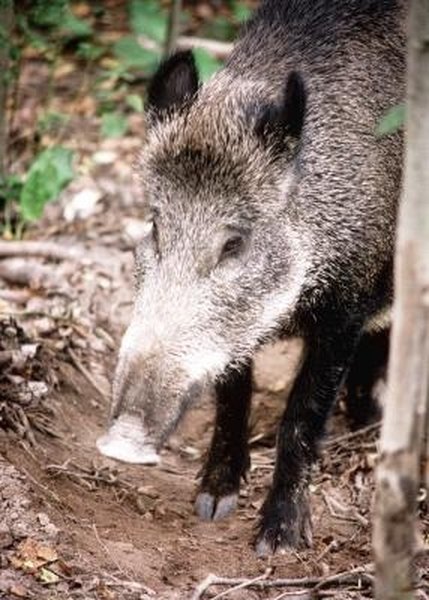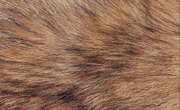
People have tanned hides for hundreds of years to create clothes, blankets and other goods. Tanning hides at home is a fairly labor-intensive process, requiring multiple days of scraping and cleaning the hide. The chemicals used in the tanning process create a number of pungent odors. Hides should be tanned outside of the home in a well-ventilated area. Hides can be tanned at home using a few simple tools and some specialty chemicals.
Items you will need
Fleshing knife
Rubber gloves
Plastic trash cans
Sheet of plywood
Finishing nails
Borax
Noniodized salt
Liquid dish soap
Washing soda
Tanning oil
Soft brush
Aluminum sulfate
Plastic sheeting
Prep
Nail the wild boar hide to a sheet of plywood at all four corners, fur-side down.
Scrape the skin with a fleshing knife to remove all the flesh and fat.
Cover all the skin using noniodized salt. Wear rubber gloves. Rub the salt into the flesh side of the hide. An average-sized boar hide will require about a 1/2 lb. of salt to cover the whole skin. Set the hide on the plywood at an angle against a wall to allow for moisture runoff; let it drain overnight.
Detach the boar skin from the plywood. Submerge the skin in a large plastic trashcan filled with cold water. Let the hide soak for 10 to 15 minutes. Wearing gloves, rinse the hide out in the trashcan.
Pull the boar hide from the trashcan and drain thoroughly. Set the hide onto the plywood fur-side down. Use a fleshing knife to scrape any remaining fat or flesh from the skin.
Combine 5 gallons of water in a trashcan with 5 oz. of borax and 3 to 5 tbsp. of dish soap. Place the hide in the trashcan. Allow skin to soak for one to two hours.
Rinse the boar hide with clean water. Hang the skin up and dry overnight.
Tanning
Mix the tanning solution. Dissolve 1 lb. aluminum sulfate in a gallon of water in a trashcan. In a separate trashcan, combine 8 oz. noniodized salt, 4 oz. washing soda and a 1/2 gallon of water. Dissolve all ingredients. Mix the washing soda liquid into the aluminum sulfate solution.
Submerge the boar hide into the tanning solution for five to seven days. After five to seven days, remove the hide with rubber gloves. Wash the hide with water and dish soap. Rinse the hide with water; hang and dry until damp.
Set the hide on the plywood, fur-side down. Warm the tanning oil in a pot on a stovetop. Use a soft brush to apply a coat of the tanning oil onto the hide. Apply a second coat of tanning oil after 30 minutes. Cover the entire hide with plastic sheeting and let stand over night.
Dry the fur side by placing it over a chair or sawhorse. Nail the hide to the plywood and stretch it out and tack it down a 1/2-inch from the hide's edge at 6 inch intervals. Dry until slightly damp.
Detach the hide from the plywood. Use the back of a wooden chair and stretch the hide from corner to corner working it over the chair back. Stretch the hide multiple times, before it completely dries. This process will create a soft skin. If needed, dampen the hide with clean water and work it in until the hide is soft and supple. Allow to completely dry.
Warnings
- Do not use metal containers; metal can react with the salts and chemicals and stain the hide.
Tips
- Tan the hide in an area with a lot of ventilation. Tanning hides causes many strong foul odors.
References
Tips
- Tan the hide in an area with a lot of ventilation. Tanning hides causes many strong foul odors.
Warnings
- Do not use metal containers; metal can react with the salts and chemicals and stain the hide.
Writer Bio
Based in Colorado, Joe Kelly has been a freelance writer since 2007. His writing has appeared in various online publications such as OC Publife, The Raiders Post, Liberty Abyss, Chasing the River and PipingShark. Kelly has a Bachelor of Science in business administration from California State University, Northridge.



